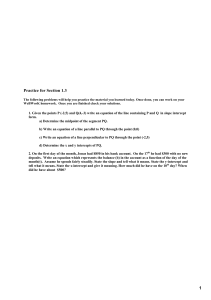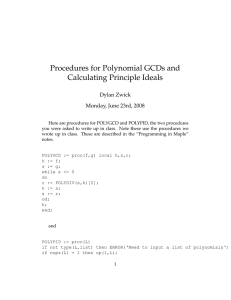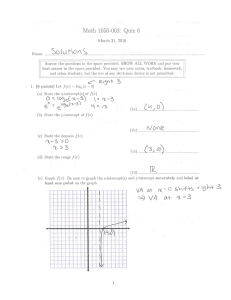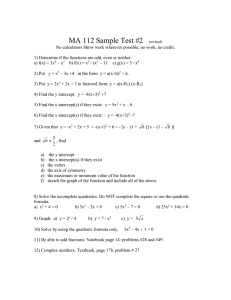Screening Designs.doc
advertisement
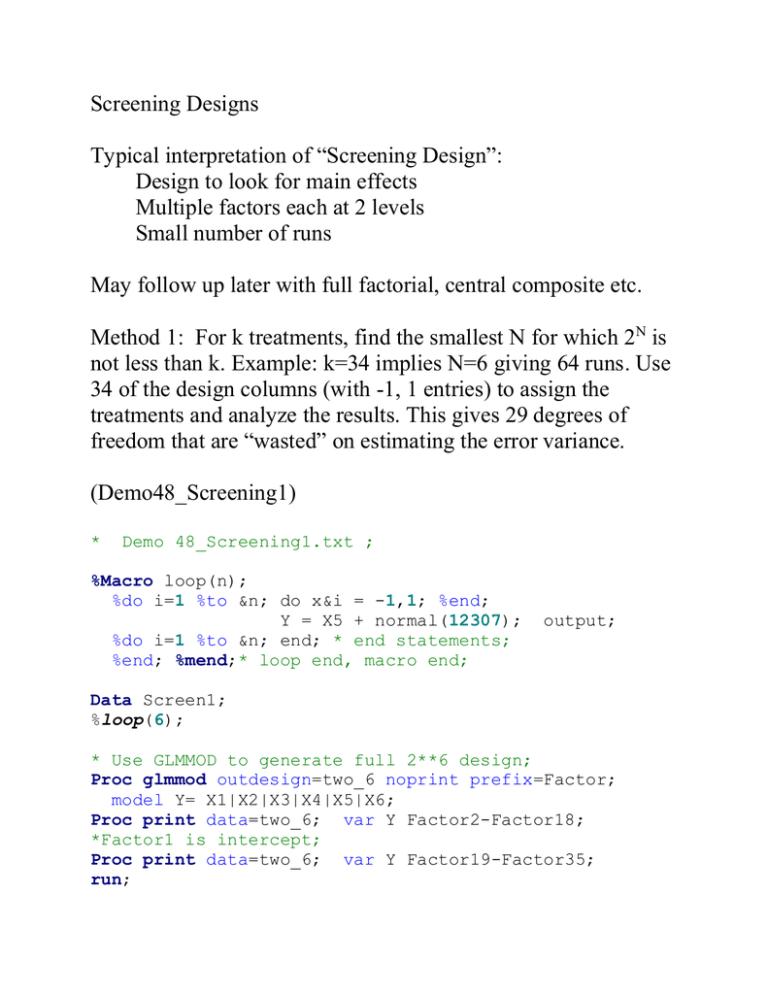
Screening Designs Typical interpretation of “Screening Design”: Design to look for main effects Multiple factors each at 2 levels Small number of runs May follow up later with full factorial, central composite etc. Method 1: For k treatments, find the smallest N for which 2N is not less than k. Example: k=34 implies N=6 giving 64 runs. Use 34 of the design columns (with -1, 1 entries) to assign the treatments and analyze the results. This gives 29 degrees of freedom that are “wasted” on estimating the error variance. (Demo48_Screening1) * Demo 48_Screening1.txt ; %Macro loop(n); %do i=1 %to &n; do x&i = -1,1; %end; Y = X5 + normal(12307); %do i=1 %to &n; end; * end statements; %end; %mend;* loop end, macro end; output; Data Screen1; %loop(6); * Use GLMMOD to generate full 2**6 design; Proc glmmod outdesign=two_6 noprint prefix=Factor; model Y= X1|X2|X3|X4|X5|X6; Proc print data=two_6; var Y Factor2-Factor18; *Factor1 is intercept; Proc print data=two_6; var Y Factor19-Factor35; run; * Run Main Effects Model; ods listing close; * turn off output; ods output ParameterEstimates=Effects; PROC REG data=two_6; model Y = Factor2-Factor35; run; quit; ods listing; *data set; proc print data=Effects; run; proc print data=Effects; var variable label tValue Probt; where probt<0.10/34; *Bonferroni; run; Partial output: O b s Y F A C T O R 2 1 2 3 4 5 6 7 8 0.09060 -1.82867 2.51503 -0.25050 -0.93802 -1.22115 1.43334 -0.99588 -1 -1 -1 -1 -1 -1 -1 -1 61 -1.32861 1 62 -1.23220 1 63 0.42493 1 64 2.04751 1 Obs 1 2 3 F A C T O R 3 -1 -1 -1 -1 -1 -1 -1 -1 1 1 1 1 Variable Intercept FACTOR2 FACTOR3 F A C T O R 4 F A C T O R 5 F A C T O R 6 1 -1 1 1 -1 1 1 -1 1 1 -1 1 1 -1 1 1 -1 1 1 -1 1 1 -1 1 (53 more 1 1 1 1 1 1 1 1 1 1 1 1 F A C T O R 7 F A C T O R 8 F A C T O R 9 1 -1 1 -1 1 -1 1 -1 1 -1 1 -1 1 -1 1 -1 lines 1 1 1 1 1 1 1 1 -1 -1 -1 -1 1 1 1 1 of 1 1 1 1 DF Estimate 1 -0.00390 1 -0.00559 1 -0.11980 F A C T O R 1 0 F A C T O R 1 1 F A C T O R 1 2 F A C T O R 1 3 F A C T O R 1 4 F A C T O R 1 5 F A C T O R 1 6 F A C T O R 1 7 F A C T O R 1 8 1 1 -1 1 1 -1 1 1 -1 1 1 -1 -1 -1 1 -1 -1 1 -1 -1 1 -1 -1 1 output) 1 1 1 1 1 1 1 1 1 1 1 1 1 1 1 1 -1 -1 -1 -1 -1 -1 -1 -1 1 1 1 1 -1 -1 -1 -1 1 1 1 1 1 1 1 1 -1 -1 -1 -1 -1 -1 1 1 -1 -1 1 1 1 1 -1 -1 1 1 -1 -1 1 1 1 1 1 1 1 1 1 1 1 1 1 -1 -1 1 -1 -1 1 1 1 1 1 1 tValue -0.03 -0.05 -1.05 Probt 0.9729 0.9611 0.3006 Label Intercept x1 x2 (30 more lines) 33 FACTOR33 1 -0.18170 -1.60 0.1207 x6 34 FACTOR34 1 0.35579 3.13 0.0040 x1*x6 35 FACTOR35 1 0.28406 2.50 0.0184 x2*x6 ---------------------------------------------------Obs Variable Label tValue Probt 17 FACTOR17 x5 9.86 <.0001 Method 2 Plackett-Burman Plans: Must have number of rows n=2 or n= 4m for integer m. Use Hadamard matrices (H with H’H=nI and each column having half 1 and half -1 entries, where n is number of rows and columns of H) Examples: 1 1 H 1 1 1 1 2 0 H , H ' H 1 1 0 2 1 1 1 1 1 1 1 1 , H ' H 4 I or H 1 1 1 1 1 1 1 1 1 1 1 1 1 1 1 1 1 1 1 1 Kronecker product is also Hadamard. Note that second 4x4 H just switches high with low levels. Can also construct design matrix from first row (tables of these in text pg. 433-435). Example: 12x12 X matrix. First column is all 1s. Next 11 entries in row 1 are (using + for +1, - for -1) next is then Each time shift all entries right 1 and replace first entry by the entry that was last in previous row. If we do this for all 12 rows, we will have repeated the first row and thus will have a matrix that is not full rank. Notice that all rows have 6 +1 and 5 -1 entries, so the sum of those 11 columns would be a column of 1s, again showing that adding an intercept column produces a matrix that is not full rank. Replacing the last row of the 12x11 array above by all -1 values before adding the intercept column gets rid of the dependency. Demo is for 8x8 matrix. The row gives second 4x4 H matrix above. * (Demo49_Screening2.txt) ; Data Plackett_Burman8; Array X(7) X1 - X7; input X1-X7; Y = 50+round(8*(4*X5 + normal(1283765))); output; put (x1-x7) (3.0); do j=2 to 7; C = X(7); do i=1 to 6; X(8-i)=X(7-i); end; X(1)=c; Y = 50+round(8*(4*X5 + normal(1283765))); output; put (x1-x7) (3.0) ; end; * last row; do j=1 to 7; X(j)=-1; Y = 50+round(8*(4*X5 + normal(1283765))); end; output; put (x1-x7) (3.0) ; cards; 1 1 1 -1 1 -1 -1 ; proc print; var Y x1-x7; run; proc reg; model Y = X1-X7/xpx; ** Suppose you have 5 factors; proc reg; model Y = X1-X5; run; Obs 1 2 3 4 5 6 7 8 Y 91 26 74 83 84 12 20 14 X1 1 -1 -1 1 -1 1 1 -1 X2 1 1 -1 -1 1 -1 1 -1 X3 1 1 1 -1 -1 1 -1 -1 X4 -1 1 1 1 -1 -1 1 -1 X5 1 -1 1 1 1 -1 -1 -1 X6 -1 1 -1 1 1 1 -1 -1 X7 -1 -1 1 -1 1 1 1 -1 Parameter Estimates Variable DF Parameter Estimate Intercept X1 X2 X3 X4 X5 X6 X7 1 1 1 1 1 1 1 1 50.50000 1.00000 4.75000 0.25000 0.25000 32.50000 0.75000 -3.00000 t Value Pr > |t| . . . . . . . . . . . . . . . . Effect of variable 5 is 2(32.5)=65=difference of two means Parameter Estimates Variable Intercept X1 X2 X3 X4 X5 DF 1 1 1 1 1 1 Parameter Estimate 50.50000 1.00000 4.75000 0.25000 0.25000 32.50000 Standard t Value Pr > |t| 23.10 0.0019 0.46 0.6923 2.17 0.1619 0.11 0.9194 0.11 0.9194 14.86 0.0045 Effect of variable 5 is 2(32.5)=65=difference of two means. No change whether other variables are included or not. Why?orthogonality! X’X=8I or 5I. Example: Chemical reaction involves 34 chemicals none of which can be omitted, but each can be at high or low level. Factorial? 234= 17,179,869,184 runs. Fractional factorial? 26 = 64 runs. Plackett-Burman design 36 runs. Design a Plackett-Burman plan and check out its performance on some generated data to make sure everything is estimable. See section 16.3.4 of text. * (Demo50_Screening3.txt) *; %let model = round(10 + 4*X5 + 3*normal(12309),.1); Data Plackett_Burman36; Array X(35) X1 - X35; keep Y x1-x35; input X1-X35; Y = &model; output; put @10 "First 20 columns after intercept"; put (x1-x20)(3.0); do j=2 to 35; C = X(35); do i=1 to 34; X(36-i)=X(35-i); end; X(1)=c; Y = &model; put (x1-x20)(3.0); output; end; do i=1 to 34; X(i)=-1; end; Y=&model; put (x1-x20)(3.0); output; *** Check log for first 20 columns **; cards; -1 1 -1 1 1 1 -1 -1 -1 1 1 1 1 1 -1 1 1 1 -1 -1 1 -1 -1 -1 -1 1 -1 1 -1 1 1 -1 -1 1 -1 ; ods listing close; ods output ParameterEstimates = effects; proc reg data=Plackett_Burman36; model Y = x1-x34; run; quit; ods listing; proc sort data=effects; by probt; proc print data=effects(obs=20); run; ---------------Partial Output -------------------------------Obs 1 2 3 4 5 6 7 8 9 10 11 12 13 14 15 16 17 18 19 20 Variable Intercept X5 X34 X18 X14 X21 X17 X26 X24 X16 X7 X30 X29 X19 X13 X1 X4 X25 X22 X11 Estimate 10.17778 4.23333 -1.27778 1.18333 0.97778 -0.97222 0.78889 -0.78333 0.76667 -0.72222 -0.69444 0.63333 -0.57778 0.50000 -0.47222 0.45556 0.43889 -0.40000 -0.35000 0.33333 tValue 305.33 127.00 -38.33 35.50 29.33 -29.17 23.67 -23.50 23.00 -21.67 -20.83 19.00 -17.33 15.00 -14.17 13.67 13.17 -12.00 -10.50 10.00 Probt 0.0021 0.0050 0.0166 0.0179 0.0217 0.0218 0.0269 0.0271 0.0277 0.0294 0.0305 0.0335 0.0367 0.0424 0.0449 0.0465 0.0483 0.0529 0.0604 0.0635 Optional reading: Box-Behnken plans are similar to the Hadamard or Plackett-Burman plans but they are factions of a 3N plan with some nice properties including the ability to run these in resolvable blocks. Section 20.5 discusses these and a table of Box-Behnken plans is on pages 557-558.

